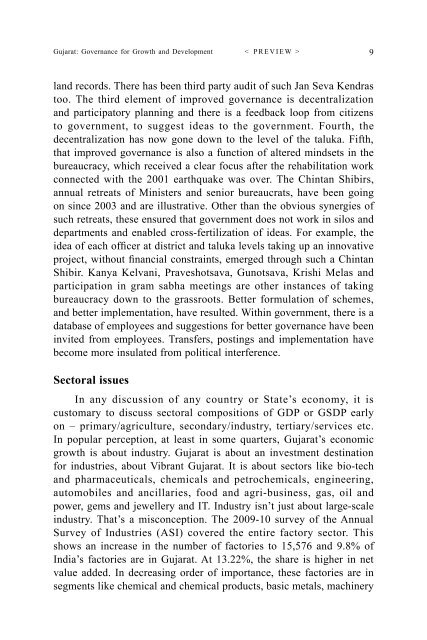Gujarat Governance for Growth and Development ... - Esamskriti.com
Gujarat Governance for Growth and Development ... - Esamskriti.com
Gujarat Governance for Growth and Development ... - Esamskriti.com
Create successful ePaper yourself
Turn your PDF publications into a flip-book with our unique Google optimized e-Paper software.
<strong>Gujarat</strong>: <strong>Governance</strong> <strong>for</strong> <strong>Growth</strong> <strong>and</strong> <strong>Development</strong> < PREVIEW ><br />
l<strong>and</strong> records. There has been third party audit of such Jan Seva Kendras<br />
too. The third element of improved governance is decentralization<br />
<strong>and</strong> participatory planning <strong>and</strong> there is a feedback loop from citizens<br />
to government, to suggest ideas to the government. Fourth, the<br />
decentralization has now gone down to the level of the taluka. Fifth,<br />
that improved governance is also a function of altered mindsets in the<br />
bureaucracy, which received a clear focus after the rehabilitation work<br />
connected with the 2001 earthquake was over. The Chintan Shibirs,<br />
annual retreats of Ministers <strong>and</strong> senior bureaucrats, have been going<br />
on since 2003 <strong>and</strong> are illustrative. Other than the obvious synergies of<br />
such retreats, these ensured that government does not work in silos <strong>and</strong><br />
departments <strong>and</strong> enabled cross-fertilization of ideas. For example, the<br />
idea of each officer at district <strong>and</strong> taluka levels taking up an innovative<br />
project, without financial constraints, emerged through such a Chintan<br />
Shibir. Kanya Kelvani, Praveshotsava, Gunotsava, Krishi Melas <strong>and</strong><br />
participation in gram sabha meetings are other instances of taking<br />
bureaucracy down to the grassroots. Better <strong>for</strong>mulation of schemes,<br />
<strong>and</strong> better implementation, have resulted. Within government, there is a<br />
database of employees <strong>and</strong> suggestions <strong>for</strong> better governance have been<br />
invited from employees. Transfers, postings <strong>and</strong> implementation have<br />
be<strong>com</strong>e more insulated from political interference.<br />
Sectoral issues<br />
In any discussion of any country or State’s economy, it is<br />
customary to discuss sectoral <strong>com</strong>positions of GDP or GSDP early<br />
on – primary/agriculture, secondary/industry, tertiary/services etc.<br />
In popular perception, at least in some quarters, <strong>Gujarat</strong>’s economic<br />
growth is about industry. <strong>Gujarat</strong> is about an investment destination<br />
<strong>for</strong> industries, about Vibrant <strong>Gujarat</strong>. It is about sectors like bio-tech<br />
<strong>and</strong> pharmaceuticals, chemicals <strong>and</strong> petrochemicals, engineering,<br />
automobiles <strong>and</strong> ancillaries, food <strong>and</strong> agri-business, gas, oil <strong>and</strong><br />
power, gems <strong>and</strong> jewellery <strong>and</strong> IT. Industry isn’t just about large-scale<br />
industry. That’s a misconception. The 2009-10 survey of the Annual<br />
Survey of Industries (ASI) covered the entire factory sector. This<br />
shows an increase in the number of factories to 15,576 <strong>and</strong> 9.8% of<br />
India’s factories are in <strong>Gujarat</strong>. At 13.22%, the share is higher in net<br />
value added. In decreasing order of importance, these factories are in<br />
segments like chemical <strong>and</strong> chemical products, basic metals, machinery<br />
9














